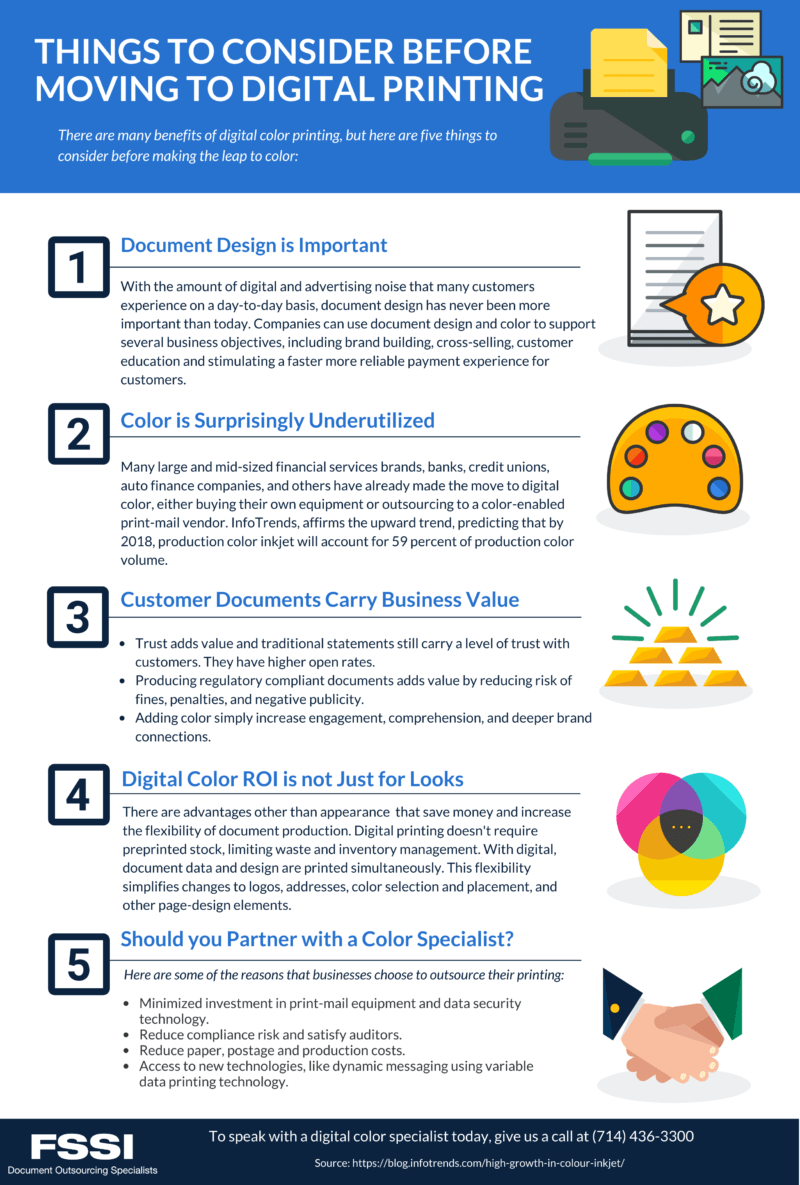The 8-Minute Rule for Digital Printing
The 8-Minute Rule for Digital Printing
Blog Article
Not known Factual Statements About Digital Printing
Table of ContentsThe Facts About Digital Printing RevealedNot known Factual Statements About Digital Printing The Buzz on Digital PrintingThings about Digital PrintingNot known Incorrect Statements About Digital Printing Digital Printing Things To Know Before You Buy
Variable data printing, such as direct mail with individualized codes and addresses, is preferably suited for electronic printing. Digital quick printing only requires four steps of layout, testimonial, printing and binding to get every little thing done. Digital quick printing has an unequaled advantage: print on need.According to PMMI, digital printing permits brands and suppliers to respond quickly to customer demands while enhancing the supply chain, reducing warehousing cost and waste, and delighting in faster time to market. That all noises excellent, however exactly how does this technology do all that? The major differentiator of these modern technologies is that there are no set up costs and no plates with digital printing.
More About Digital Printing
According to Wikipedia, the best difference between digital printing and standard approaches such as lithography, flexography, gravure, or letterpress - Digital Printing is that there is no demand to change printing plates in electronic printing, whereas in these analog printing approaches the plates are repetitively replaced. This results in quicker turnaround time and decreases expense when making use of electronic printing.
Fast production means obtaining your product to market quicker. It also suggests it's simpler and faster to make modifications in the future, when you alter a recipe, include a SKU, or develop seasonal packaging. Digital printing is highly adaptable, so it's easy to make modifications to the plan style quickly. All of it returns to the plates.
Extra inventory can indicate more waste later on. With standard printing techniques, short-run printing is simply not feasible. Since a terrific design can make or break your item, electronic printing regularly develops high-quality, clear and vivid graphics each time. Digital printing on flexible bags includes the bright, dynamic, and exact graphics that almost beckon consumers to get to out and touch them.
Digital printing is the process of printing digital-based images straight onto a selection of media substratums. There is no requirement for a printing plate, unlike with offset printing. Digital data such as PDFs or desktop computer publishing files can be sent out straight to the digital printing machine to publish on paper, picture paper, canvas, material, synthetics, cardstock and other substratums.
Not known Facts About Digital Printing
According to PMMI, electronic printing permits brands and makers to react promptly to customer find more information needs while improving the supply chain, lowering warehousing cost and waste, and appreciating faster time to market. That all sounds great, yet how does this technology do all that? The significant differentiator of these technologies is that there are no set up fees and no plates with electronic printing.
According to Wikipedia, the biggest difference between electronic printing and conventional approaches such as why not check here lithography, flexography, gravure, or letterpress is that there is no need to change printing plates in electronic printing, whereas in these analog printing techniques the plates are consistently changed. This results in quicker turnaround time and decreases expense when utilizing digital printing.

Examine This Report on Digital Printing
With conventional printing methods, short-run printing is just not feasible. Because a terrific design can make or break your item, digital printing regularly develops premium, clear and vivid graphics each time.

According to PMMI, digital printing enables brands and manufacturers to respond swiftly to customer needs while boosting the supply chain, minimizing warehousing expense and waste, and enjoying faster time to market. That all noises great, however just how does this modern technology do all that? The significant differentiator of these modern technologies is that there are no set up costs and no plates with electronic printing.
The smart Trick of Digital Printing That Nobody is Talking About
According to Wikipedia, the best distinction in between electronic printing and traditional approaches such as lithography, flexography, gravure, or letterpress is that there is no need to replace printing plates in digital printing, whereas in these analog printing methods the plates are repeatedly changed. This causes quicker turnaround time and decreases expense when making use of electronic printing.
Digital printing is highly adaptable, so it's easy to make modifications to the package design rapidly. It all goes back to the plates.

See This Report on Digital Printing
Digital printing is the procedure of printing digital-based photos straight onto a selection of media substratums. There is no requirement for a printing plate, unlike with offset printing. Digital data such as PDFs or desktop publishing documents can be sent directly to the electronic printing machine to print theoretically, image paper, canvas, fabric, synthetics, cardstock and other substrates.
Report this page